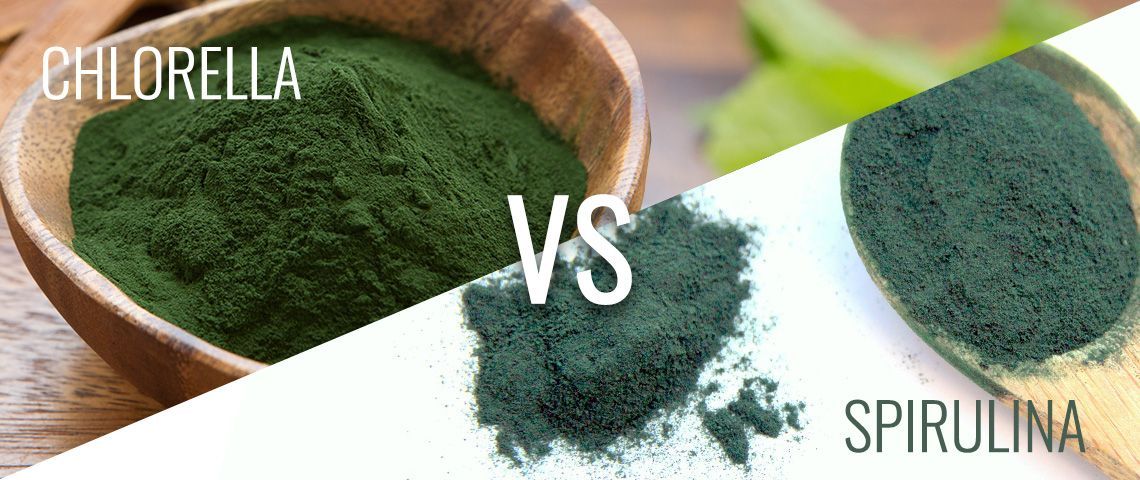
Chlorella vs. Spirulina: What is the Difference?
Chlorella and spirulina are two types of freshwater algae that have gained popularity as dietary supplements due to their rich nutritional profiles and potential health benefits. While both are considered superfoods and share some similarities, they are distinct organisms with unique characteristics. In this comprehensive guide, we’ll explore the differences between chlorella and spirulina in terms of their appearance, nutritional content, health benefits, and culinary uses to help you make an informed choice about which one may be best suited for your needs.
Appearance and Habitat
Chlorella
Chlorella is a single-celled green freshwater algae that belongs to the phylum Chlorophyta. It is spherical in shape and typically ranges from 2 to 10 micrometers in diameter, making it one of the smallest organisms on Earth visible to the naked eye. Chlorella thrives in freshwater environments such as ponds, lakes, and rivers and is capable of photosynthesis, converting sunlight into energy using chlorophyll. It has a vibrant green color due to its high chlorophyll content.
Spirulina
Spirulina is a spiral-shaped blue-green freshwater algae that belongs to the phylum Cyanobacteria. It is a multicellular organism that forms long, filamentous chains and can grow up to 100 times larger than chlorella. Spirulina is found in alkaline lakes and ponds in tropical and subtropical regions around the world, where it forms dense mats or blooms on the water’s surface. It has a bluish-green color due to its high phycocyanin content, a pigment similar to chlorophyll.
Nutritional Content
Chlorella
Chlorella is a nutritional powerhouse that is rich in essential nutrients, including protein, vitamins, minerals, antioxidants, and chlorophyll. It is an excellent source of complete protein, containing all nine essential amino acids, as well as vitamins A, B vitamins (including B12), C, E, and K. Chlorella also contains high levels of iron, magnesium, zinc, potassium, and calcium, as well as antioxidants such as beta-carotene and lutein.
Spirulina
Spirulina is also highly nutritious and contains a similar range of essential nutrients as chlorella, including protein, vitamins, minerals, antioxidants, and chlorophyll. It is particularly rich in protein, with a protein content of up to 60-70% by weight, making it one of the most protein-dense foods available. Spirulina is also a good source of vitamins A, B vitamins (including B12), C, E, and K, as well as iron, magnesium, zinc, potassium, and calcium.
Health Benefits
Chlorella:
Chlorella has been studied for its potential health benefits, which include detoxification, immune support, and antioxidant protection. It is rich in chlorophyll, which has been shown to support the body’s natural detoxification processes by binding to heavy metals and toxins and promoting their elimination from the body. Chlorella also contains unique compounds such as Chlorella Growth Factor (CGF), which has been shown to support immune function and promote cellular repair and regeneration.
Spirulina
Spirulina is also associated with numerous health benefits, including immune support, antioxidant protection, and anti-inflammatory properties. It contains phycocyanin, a powerful antioxidant and anti-inflammatory compound that has been shown to protect against oxidative stress and reduce inflammation in the body. Spirulina is also rich in gamma-linolenic acid (GLA), an omega-6 fatty acid with anti-inflammatory properties, as well as polysaccharides and peptides that support immune function.
Culinary Uses
Chlorella
Chlorella is typically consumed in powdered or tablet form as a dietary supplement. It has a strong, earthy taste that can be off-putting to some people, so it is often mixed with other ingredients such as fruit juices or smoothies to mask its flavor. Chlorella powder can also be added to soups, sauces, salad dressings, and baked goods for added nutritional value.
Spirulina
Spirulina is also commonly consumed in powdered or tablet form as a dietary supplement. It has a mild, slightly sweet taste that blends well with a variety of foods and beverages. Spirulina powder can be added to smoothies, juices, yogurt, and salad dressings for a nutritional boost. It can also be used as a natural food coloring agent in recipes such as pasta, bread, and desserts.
Safety and Side Effects
Both chlorella and spirulina are generally considered safe for most people when consumed in moderation as dietary supplements. However, some individuals may experience side effects such as digestive discomfort, nausea, or allergic reactions, particularly if they are sensitive to algae or iodine. It is important to consult with a healthcare professional before starting any new dietary supplement, especially if you have underlying health conditions or are pregnant or breastfeeding.
Conclusion
In conclusion, chlorella and spirulina are two types of freshwater algae that offer a wide range of potential health benefits due to their rich nutritional content. While they share some similarities, such as their high protein and antioxidant content, they also have distinct differences in terms of appearance, habitat, taste, and culinary uses. Whether you choose chlorella or spirulina may depend on your personal preferences, dietary goals, and health concerns. Incorporating these nutrient-rich algae into your diet may help support overall health and well-being, but it is important to consume them as part of a balanced diet and consult with a healthcare professional if you have any concerns.
- Vessel’s Core Series Review: Stylish and Versatile Gear for Every Taste! - August 22, 2024
- Benefits of Bladderwrack Supplements - April 2, 2024
- Benefits of Black Walnut Supplements - April 2, 2024